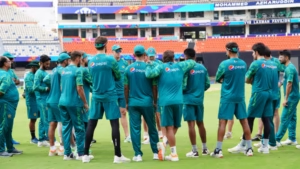ICC Cricket World Cup 2023: Analyzing the Strengths and Weakness of Pakistan
By Swapneel Deshpande 01 Oct 2023, 17:45 IST


Pakistan, after a disappointing Asia Cup 2023, is gearing up for the upcoming World Cup in the subcontinent, led by Babar Azam. Although it’s been a while since they played in India, the conditions are familiar, offering them a home-ground advantage. Reports of team disunity have raised concerns, placing pressure on Babar. Nevertheless, Pakistan boasts a strong World Cup squad with a history of surprising performances.
Their 1992 World Cup win remains iconic, and they now aim to conquer their arch-rivals’ turf. Strengths include a talented squad and familiarity with subcontinental conditions. Weaknesses revolve around the team’s unity issues and inconsistency. Opportunities lie in channeling their reputation for surprising victories.
As Pakistan enters the World Cup, they have the potential to overcome internal challenges and harness their strengths to make a formidable impact on the tournament, echoing the glory of their past triumph in 1992. In this analysis, we dissect Pakistan’s strengths and weaknesses as they aim to secure their second World Cup title.
Strengths:
Pace Battery:
Pakistan possesses one of the most formidable pace bowling attacks in world cricket. The trio of Shaheen Afridi, Haris Rauf, and Hasan Ali is capable of wreaking havoc on opposition batting line-ups. Shaheen Afridi’s ability to swing the ball and Haris Rauf’s express pace make them a lethal combination. Hasan Ali, with his experience, can provide crucial breakthroughs. Their collective pace and skill can be a significant advantage, especially in conditions that favor fast bowlers.
Top-Order Batting:
Pakistan’s top-order batting is anchored by their skipper, Babar Azam. Babar is widely regarded as one of the best batsmen in the world and has a remarkable record in subcontinent conditions. His consistency and ability to build innings are assets for Pakistan. Additionally, Fakhar Zaman, with his aggressive batting style, can provide valuable starts and set the tone for the innings. A strong top-order can help Pakistan post competitive totals and chase down targets effectively.
Weaknesses:
Middle-Order Instability:
One of the significant weaknesses of the Pakistan cricket team is the inconsistency and instability in their middle-order batting. In crucial matches and high-pressure situations, the middle-order has often faltered, leading to batting collapses. Players like Mohammad Rizwan, Iftikhar Ahmed, and Salman Ali Agha, who are expected to play crucial roles in the middle order, need to improve their consistency and composure. Without a reliable middle-order, Pakistan could struggle to recover from early setbacks or build substantial partnerships.
Spin Bowling Concerns:
Pakistan traditionally relies on spinners to provide crucial breakthroughs and control the game in subcontinent conditions. However, in recent times, their spin department, particularly Shadab Khan, has faced issues with form and performance. Shadab, being the lead spinner, needs to regain his confidence and effectiveness as a wicket-taking option. The ability of spinners to exploit turning tracks will be vital, as spin-friendly conditions can play a significant role in subcontinental venues. If Pakistan’s spinners don’t perform up to expectations, it could put extra pressure on the pace bowlers and affect the team’s balance.
In summary, Pakistan’s strengths lie in their formidable pace attack and a strong top-order batting led by Babar Azam. However, they need to address their middle-order instability and spin bowling concerns to enhance their chances of success in the ICC Men’s Cricket World Cup 2023.
Stay updated with all the cricketing action, follow Cricadium on Facebook, Twitter, and Instagram
You might also like
Recommended to you













